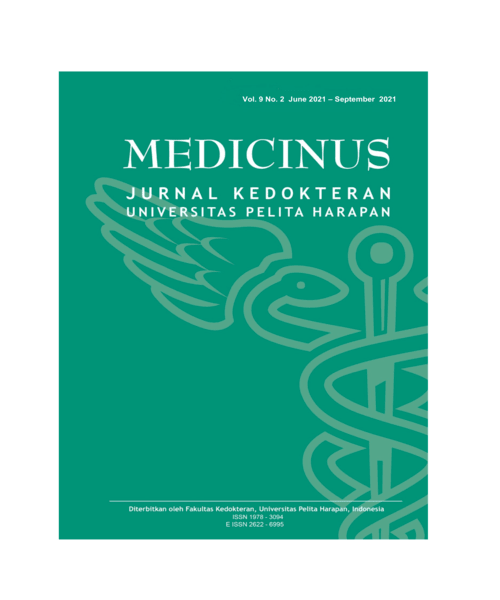A 1-Month-Old Baby with Osteogenesis Imperfecta: A Case Report
DOI:
https://doi.org/10.19166/med.v9i2.4706Keywords:
congenital abnormalities, osteogenesis imperfecta, pediatricsAbstract
Osteogenesis imperfecta (OI) is a connective tissue formation disorder that is generally characterized by bone fragility, osteopenia, blue sclera, dentinogenesis imperfecta (DI), and hearing loss. This disease occurs due to changes in collagen type 1 that form the basis of bone formation so that bones tend to be thinner and smaller. The bones become weak and easily cracked. OI has been classified by type according to the system based on the mode of inheritance, clinical features, and information from the X-ray. There are four types of osteogenesis imperfecta, namely Type I, Type II, Type III, and Type IV. Health problems are often seen in children and adults who have OI include: short stature, weak tissues, fragile skin, muscle weakness, and loose joints, bleeding, easy bruising, frequent nosebleeds, and tiny amounts of heavy bleeding from the wound, impaired loss of hearing can begin in childhood and affects approximately 50 % of adults, breathing problems, a higher incidence of asthma plus risk for other lung problems, spinal curvature.
References
1. Al-Agha AE, Hayatalhazmi RS. Osteoporosis treatment with zoledronic acid in the pediatric population at a university hospital in Western Saudi Arabia. Saudi Med J. 2015; 36: 1312-1318. https://doi.org/10.15537/smj.2015.11.12590
2. Alharbi, SA. 2016. A systematic overview of osteogenesis imperfecta. Mol Biol. 2016; 5: 1-9. http://doi.org/10.4172/2168-9547.1000150
3. Byers PH, Krakow D, Nunes ME, Pepin M. Genentics in Medicine. 2006; 8: 383-388. https://doi.org/10.1097/01.gim.0000223557.54670.aa
4. Dijk VFS, Sillence DO. Osteogenesis imperfecta: clinical diagnosis, nomenclature, and severity assessment. Am J Med Genet Part A. 2014; 164A: 1470-1481.https://doi.org/10.1002/ajmg.a.36545
5. Letocha AD, Cintas HL, Troendle JF, Reynolds JC, Cann CE, Chernoff EJ, dkk. A controlled trial of pamidronate in children with types III and IV osteogenesis imperfecta confirms vertebral gain but not a short-term functional improvement. J Bone and Mineral. 2005; 20: 977-986. https://doi.org/10.1359/JBMR.050109
6. Lindahl K, Kindmark A, Rubin CJ, Malmgren B, Grigelioniene G, Söderhäll S. Decreased fracture rate, pharmacogenetics and BMD response in 79 Swedish children with osteogenesis imperfecta types I, III and IV treated with pamidronate. Bone. 2016; 87: 11-18. https://doi.org/10.1016/j.bone.2016.02.015
7. Marzuki NS, Batubara JRL. Osteogenesis Imperfecta. In: Batubara JRL, Tridjaja B, Pulungan A, Editors. Buku Ajar Endokrinologi Anak. 2nd ed. In Press.
8. Rijks EBG, Bongers BC, Vlemmix MJG, Boot AM, van Dijk ATH, Sakkers RJB, dkk. Efficacy and safety of bisphosphonate therapy in children with osteogenesis imperfecta: systematic review, hormone research in pediatrics. Horm Res Paediatr. 2015; 84: 26-42. https://doi.org/10.1159/000381713
9. Sánchez-Sánchez LM, Cabrera-Pedroza AU, Palacios-Saucedo G, de la FuenteCortez B Zoledronic acid (zoledronate) in children with osteogenesis imperfecta (OI). Gac Med Mex. 2015; 151: 152-156.
10. Starr RS, Roberts TT, Fischer PR. Osteogenesis Imperfecta: Primary Care. Ped in Review. 2010; 31: e54-e64. https://doi.org/10.1542/pir.31-8-e54
11. van Dijk FS, Byers PH, Dalgleish R, Malfait F, Maugeri A, Rohrbach M, dkk. Best practice guidelines for the laboratory diagnosis of osteogenesis imperfecta. European Journal of Human Genetics. 2012; 20: 11-19. https://doi.org/10.1038/ejhg.2011.141
12. Zeitlin L, Rauch F, Plotkin H, Glorieux FH. Height and weight development during four years of therapy with cyclical intravenous pamidronate in children and adolescents with osteogenesis imperfecta types I, III, and IV. Pediatrics. 2003; 111: 1030-6. https://doi.org/10.1542/peds.111.5.1030
Downloads
Published
How to Cite
Issue
Section
License
Copyright (c) 2021 Andry Juliansen, Anne Meilyn, Lisa Rehinda Tampake

This work is licensed under a Creative Commons Attribution-ShareAlike 4.0 International License.
Authors who publish with this journal agree to the following terms:
1) Authors retain copyright and grant the journal right of first publication with the work simultaneously licensed under a Creative Commons Attribution License (CC-BY-SA 4.0) that allows others to share the work with an acknowledgement of the work's authorship and initial publication in this journal.
2) Authors are able to enter into separate, additional contractual arrangements for the non-exclusive distribution of the journal's published version of the work (e.g., post it to an institutional repository or publish it in a book), with an acknowledgement of its initial publication in this journal.
3) Authors are permitted and encouraged to post their work online (e.g., in institutional repositories or on their website). The final published PDF should be used and bibliographic details that credit the publication in this journal should be included.





